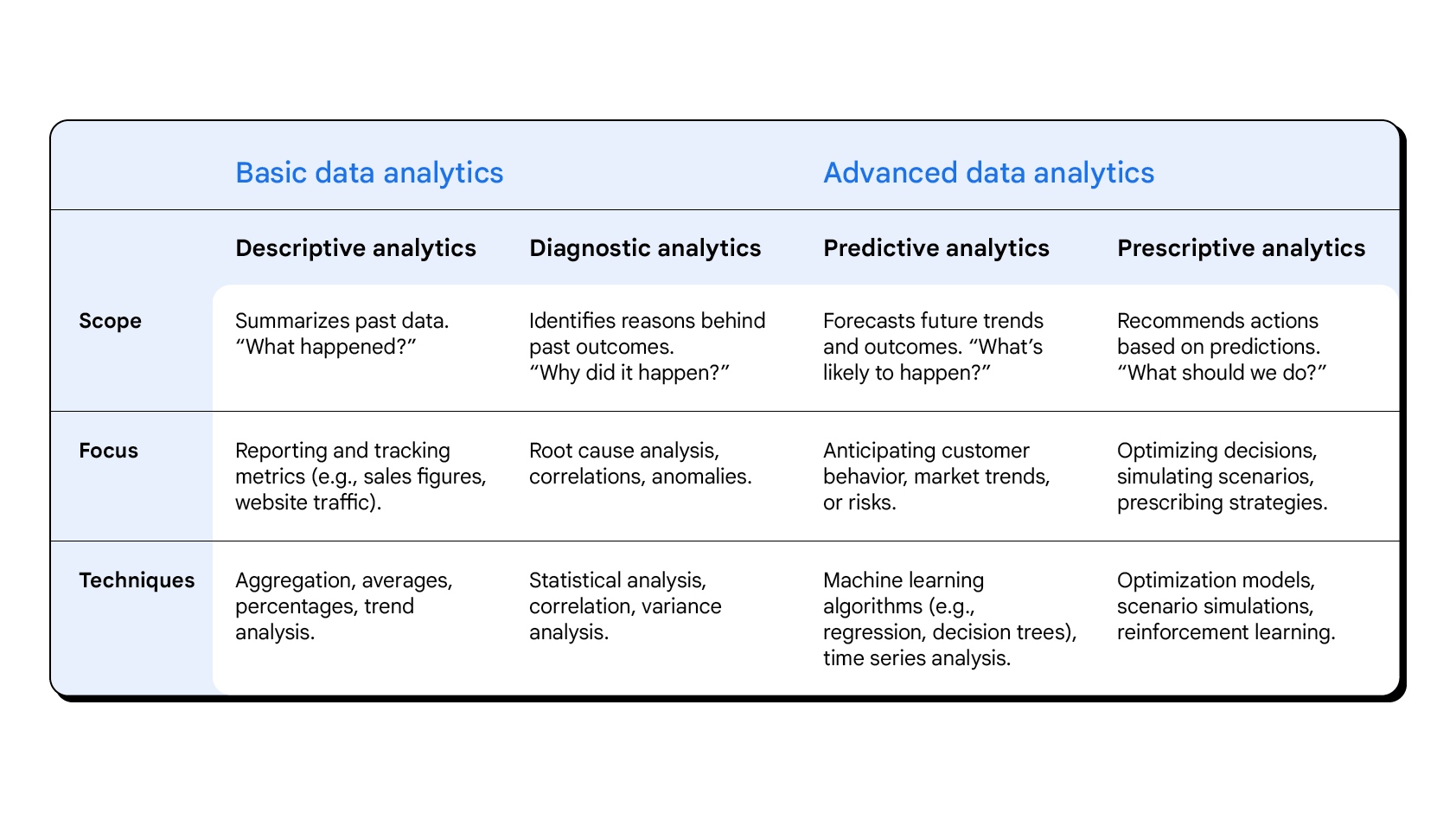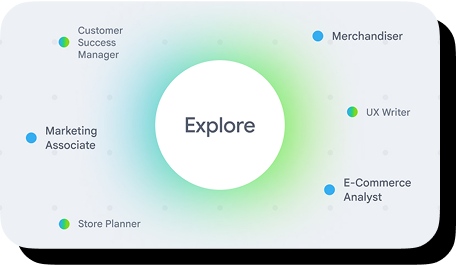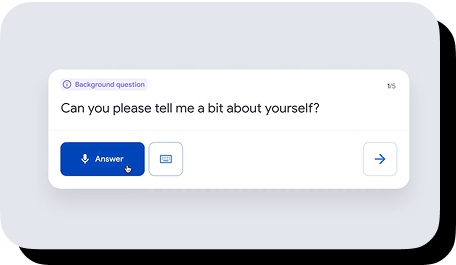
What is advanced data analytics?

How to think about advanced data analytics
For data scientists and practitioners, the concept of advanced data analytics represents a shift in how you derive insights from data, moving beyond describing what’s happened in the past, and shifting towards predicting what may happen in the future. Advanced data analysis of that kind will require more sophisticated techniques like machine learning, statistical modeling, and regression analysis. Rather than just creating a descriptive dashboard with historical trends, advanced analytics involves using tools like Python to build predictive models and conduct exploratory data analysis (EDA) to uncover deeper insights. The goal is to move from reactive analysis to proactive, data-driven decision-making, using experimental design and other methods to test hypotheses and prescribe the best actions for a business.
How advanced data analytics works
Practitioners of advanced data analytics take the same, fundamental concepts behind basic data analysis and apply them to more complex challenges using more powerful tools. One of the challenges uniquely handled by advanced data analysis techniques is the processing of “unstructured data.” This is data without the predefined formatting you’d find in a spreadsheet or database. Think of all the text, images, video, and audio that make up the internet. That’s often unstructured, unprocessed data containing valuable insights for those who can extract them.
By combining sophisticated techniques like machine learning, statistical modeling, and more, analysts using advanced data analysis skills can forecast trends, recommend specific actions, and uncover hidden patterns within both structured and unstructured data.
Advanced analytics techniques
Some of the techniques you may require for advanced analytics include:
- Machine learning techniques: By training algorithms to recognize patterns in historical data or uncover hidden relationships in unstructured information, machine learning helps automate complex analytical tasks and enables smarter, faster decision-making.
- Natural language processing (NLP): As a branch of machine learning, NLP focuses on interpreting and analyzing human language to gain insight from text-based data, like customer reviews or social media posts.
- Sentiment analysis: A subset of NLP, sentiment analysis evaluates the emotional tone behind text. This helps computers understand things like public perception or customer satisfaction.
- Regression analysis: Techniques like linear regression and logistic regression help identify relationships between variables and predict outcomes (e.g., forecasting sales based on advertising spend).
- Hypothesis testing: Methods like A/B testing and significance testing evaluate whether observed differences are statistically meaningful (e.g., comparing two marketing campaigns).
- Statistical modeling: Based on probabilities, statistical modeling builds predictive models using historical data to anticipate future trends or risks.
- Cluster analysis: A technique that groups data points based on shared characteristics, cluster analysis reveals patterns or segments within large datasets (e.g., identifying customer personas for targeted marketing).
- Big data analytics: Some datasets are exceptionally large, fast-moving, or diverse, exceeding the limits of traditional tools. Using the methods above, advanced data analysts can harness more information and derive deeper insights than is possible with standard tools.
Data analytics vs. advanced data analytics
The table below shows how basic and advanced data analytics use different methods to answer different questions:
Key skills for advanced data analytics jobs
As data analytics tackles more advanced problems, the underlying analytical process actually remains the same: Define the problem, gather and prepare data, analyze it for insights, communicate findings clearly, and implement solutions based on those insights. What changes is the complexity of each step and the techniques deployed, based on the kinds of problems you’re solving. To advance in your data analytics career, you’ll need to develop new skill sets.
Advanced Statistical and Machine Learning Methods
Going beyond basic averages and percentages, advanced analysts use higher-level statistical techniques like regression analysis, hypothesis testing, and time series forecasting to extract deeper insights. These methods help identify hidden patterns, test the significance of differences, and predict future trends with greater accuracy. In addition, advanced data analytics often incorporates machine learning algorithms, such as classification and clustering, to build predictive models and uncover complex relationships that traditional statistics can't.
Advanced data preparation and cleaning
While the fundamental principles of data preparation and cleaning are the same, advanced analytics handles big datasets, unstructured data (like text, audio, and video), and high-dimensional data (i.e. data with many kinds of attributes). This requires expertise in advanced techniques for data wrangling, feature engineering, and handling missing or noisy data. Instead of just cleaning a single dataset, advanced analysts may need to integrate data from multiple, disparate sources, ensuring quality and consistency across a complex data environment.
Complex data visualization
Where foundational data analytics begins with clear, effective tools like simple charts, line graphs, or scatter plots, advanced visualization ventures into the realm of heat maps, network diagrams, and interactive dashboards. Part of advanced analytics is knowing which tool best communicates a complex idea to stakeholders.
Higher-order programming and coding skills
Many data analysts use programming languages like Python for everyday tasks, but advanced analytics requires more sophisticated coding skills. Higher-level analysts may need to design and implement custom functions and algorithms for machine learning or debug complex code. While basic analytics tends to apply pre-existing knowledge to solve well-defined problems, advanced analytics may require inventing entirely new techniques to solve novel problems.
Standard software and computing power is too limited to handle and process big data. This is when advanced data analysts turn to bigger tools like cloud computing or distributed computing frameworks for more storage and computational power.
Communication and storytelling
As you progress to solving larger organizational problems, your soft skills must evolve alongside your technical abilities. When tackling more complex challenges, you'll increasingly find yourself:
- Communicating sophisticated concepts to senior stakeholders.
- Delivering recommendations that drive significant business decisions.
- Supporting your findings with more rigorous evidence and justification.
- Bridging the gap between technical teams and non-technical decision-makers.
The stakes become higher as your analyses inform more consequential decisions. Your ability to translate complex findings into clear, actionable insights becomes just as valuable as your technical expertise — perhaps even more so.
Real-world applications of advanced analytics
When you think of data analytics, you might picture spreadsheets and pie charts. These are both important tools, of course, but high-level analytics have helped build much of the world around us. Here are some examples of advanced analytics in your everyday life:
- Personalized recommendations: Ever wondered how streaming services know which songs you’ll like? Data scientists build recommendation engines that analyze your past activity. They use machine learning to find patterns, combining collaborative filtering (comparing you to similar users) with content analysis (understanding what makes shows or products similar) to predict what you'll enjoy next.
- Fraud detection: When your credit card company texts about a suspicious purchase, that's advanced analytics at work. Data scientists train anomaly-detection algorithms on millions of transactions to identify unusual patterns. These models learn to distinguish normal spending from potential fraud, helping financial institutions prevent problems before they happen.
- Supply chain optimization: Behind efficient deliveries and well-stocked shelves are prescriptive analytics systems. Analysts use optimization algorithms to simulate "what-if" scenarios, helping companies determine the fastest routes, optimal inventory levels, and best warehouse locations. These systems continuously learn from new data so they can adapt to changing conditions.
- Healthcare insights: Advanced analytics helps save lives by predicting patient outcomes. Data scientists build models that analyze medical records, genetic information, and treatment histories to identify risk factors and recommend personalized care plans. Hospitals use these insights to prevent readmissions and improve treatment effectiveness.
- Customer segmentation: Marketing teams use clustering algorithms to identify distinct customer groups with shared behaviors and preferences. Advanced analysts process purchase histories, demographic data, and online interactions to discover natural groupings that might not be obvious. This allows businesses to create targeted campaigns that speak directly to specific customer needs.
Learn more
Advanced analytics techniques let you journey deeper into data, revealing invisible patterns and glimpses of potential futures. You’d learn how to use bleeding-edge technology to solve never-before-seen problems and offer paradigm-shifting insights to your partners and teammates. If you’re interested in taking your data analyst career further, consider the Google Advanced Data Analytics Certificate. Designed by experts in the field, this program offers training on core concepts, skills, and techniques professionals use every day to transform data into strategic solutions.









